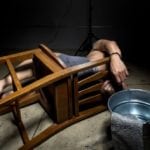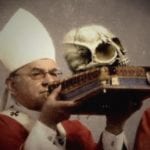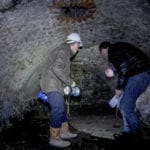 Weird Stuff
Weird Stuff  Weird Stuff
Weird Stuff  Animals
Animals 10 Inspiring Tales of Horses Being Human
 Mysteries
Mysteries Top 10 Haunting Facts About the Ghost Ship MV Alta
 History
History 10 Surprising Stories About the Texas Rangers
 Humans
Humans 10 Philosophers Who Were Driven Mad by Their Own Theories
 Miscellaneous
Miscellaneous 10 Video-Game-Worthy Weapons and Armors from History
 Weird Stuff
Weird Stuff 10 Psychics Who Accurately Predicted Wartime Events
 The Arts
The Arts 10 Pieces of Art Inspired by a Broken Heart
 Health
Health 10 Science Fiction-Sounding New Medical Treatments
 History
History 10 Surprising Facts About the Father of Submarine Warfare
 Weird Stuff
Weird Stuff 10 Times Real Laws Were Based on Bizarre Hypotheticals
 Animals
Animals 10 Inspiring Tales of Horses Being Human
 Mysteries
Mysteries Top 10 Haunting Facts About the Ghost Ship MV Alta
Who's Behind Listverse?

Jamie Frater
Head Editor
Jamie founded Listverse due to an insatiable desire to share fascinating, obscure, and bizarre facts. He has been a guest speaker on numerous national radio and television stations and is a five time published author.
More About Us History
History 10 Surprising Stories About the Texas Rangers
 Humans
Humans 10 Philosophers Who Were Driven Mad by Their Own Theories
 Miscellaneous
Miscellaneous 10 Video-Game-Worthy Weapons and Armors from History
 Weird Stuff
Weird Stuff 10 Psychics Who Accurately Predicted Wartime Events
 The Arts
The Arts 10 Pieces of Art Inspired by a Broken Heart
 Health
Health 10 Science Fiction-Sounding New Medical Treatments
 History
History 10 Surprising Facts About the Father of Submarine Warfare
10 Secret Adventures Of Richard Nixon
You’ve all heard he’s not a crook, but what else is there to know about Richard Nixon? We’ve already covered quite a few facts about the 37th president, including his tendency to play mad, his meeting with Elvis Presley, and his most amazing accomplishments. However, Nixon’s legacy is crazier and more complex than any other president’s. His life is so full of strange stories and odd anecdotes that Nixon definitely deserves another list dedicated to his crooked and confusing life.
10Nixon Wanted To Be An FBI Agent

We’ve all played the “what if” game. What if Hitler had succeeded as a painter? What if JFK hadn’t gone to Dallas? What if Bruce Wayne’s parents hadn’t been murdered? Well, here’s another little mind game for you: What if Richard Nixon had become an FBI agent? While studying law at Duke University, Nixon attended a lecture by a visiting G-man and was inspired to become a fed. Then in 1937, at the age of 24, Nixon mailed in his application and was given a job interview.
All in all, the interview went pretty well. While the interviewer pointed out that Nixon was a terrible typist and had no firearm experience, he seemed pretty impressed with the would-be agent. He noted that Nixon was “above average in intelligence and mental alertness,” possessed “good common sense,” could “inspire confidence,” and was “manly appearing, possessing a good physique.” Nevertheless, Nixon’s FBI career never went any further than that initial interview.
Years later, after Nixon became Dwight Eisenhower’s Vice President, he asked J. Edgar Hoover what had happened to his application. As it turns out, Nixon had been approved and was all set to become an agent when the top brass changed their minds. This was probably due to either budget cuts or because Nixon’s plan to take the California bar exam conflicted with the Bureau’s hiring schedule. Either way, it’s one of those little moments that totally shaped world history. Ironically, the man who ultimately ratted Nixon out would turn out to be an FBI agent.
9Poker Master

Look up the word “ruthless” in the dictionary, and you might just find a photograph of Richard Nixon. The man was a politician’s politician, a conniving cutthroat who could tell a lie and keep a straight face. Not surprisingly, Tricky Dick was also a pretty good poker player. The skills that won Nixon the White House also earned him quite a bit of cash during the 1940s.
It was May 1944, World War II had one year left to go, and Nixon was stationed on Green Island off the coast of Papua New Guinea. Nixon was the man in charge of loading and unloading cargo planes. But when he wasn’t hauling crates, Nixon was running a little bar called “Nick’s.” Not only did he sell beer, he was also reputed to serve the “coldest pineapple juice in the South Pacific.” After a hard day’s work, sailors could relax in Nixon’s little hangout and sip a cool beverage . . . while he cleaned them out at cards.
According to historian Rick Perlstein, Nixon probably learned how to play poker during his days as a carnie in Arizona. Wherever he picked up the game, the man definitely knew how to deal. He was particularly skilled at five-card stud and once bluffed his way to $1,500 with only a pair of twos.
Nixon was so obsessed with poker that he even gave up the chance to meet Charles Lindbergh—one of the most famous people on the planet—so he could play cards with his pals. And his dedication to the game paid off in spades. He used his winnings to cover several debts back home and used the remainder to finance his first congressional race. Whatever his shortcomings, he was a man who really knew how to hold ’em.
8Nixon vs. Dick Tuck

Dick Tuck is the world’s greatest political prankster. He’s punked notable figures like Barry Goldwater and Ronald Reagan, but he’s best known for tormenting poor Richard Nixon. Their antagonistic relationship started in 1950 when Nixon was running for the Senate. Working for Nixon’s Democratic opponent, Tuck got a job working as a campaign manager on Nixon’s staff. His first big stunt involved renting a huge auditorium and keeping the event as quiet as possible. When Nixon showed up to speak, he found he was addressing 40 people in a room built for 4,000.
Things only got worse when Vice President Nixon was stumping for reelection in 1956. That year, the Republicans were holding their convention in San Francisco. They picked the worst possible spot—the road running past the convention center happened to lead to a garbage dump. No doubt rubbing his hands with glee, Tuck arranged for all the garbage trucks to drive past the convention center while equipped with signs that read “Dump Nixon.”
Tuck’s most famous stunt came about in 1962 when Nixon was running for the California governorship. Tuck learned that eccentric businessman Howard Hughes once loaned Nixon’s brother $200,000, probably in an effort to buy Nixon’s favor. Knowing a golden opportunity when he saw one, Tuck had several signs drawn up and passed them out to citizens living in Chinatown.
When Nixon showed up to press the flesh, he noticed several signs that read “Welcome Nixon!” He probably assumed the Chinese characters underneath said the same thing, but they actually read “What about the Hughes loan?” (Well, due to a mistranslation, they technically said “What about the huge loan?”) When Nixon discovered the trick, he actually grabbed one of the signs and tore it to pieces—on camera.
A few other pranks involved Tuck telling people to play “Mack the Knife” at Nixon rallies. That way, the president would be greeted with a song about a murderous thug. One hysterical trick, which Tuck himself denied ever took place, involved having pregnant black women attend a Nixon speech while holding signs that read, “Nixon’s the One.” And according to legend, while Nixon was speaking to a crowd from the back of a train, Tuck donned a trainman’s hat and told the engineer to pull away, right in the middle of Tricky Dick’s speech.
Tuck eventually retired from his trickster ways, which is too bad. In an age of hot-headed talk show hosts and partisan politicians, we really need someone like Tuck to lighten the mood.
7The Presidential All-Star Team

The say baseball is America’s national pastime, so it’s only proper if the president knows a thing or two about the game. Richard Nixon was a die-hard fan. During his time at the White House, he attended 11 games and became the first president to throw an opening pitch on the West Coast. He was also the first and only president to devise his own fictional all-star teams, partly for his love of the game and partly to win political points.
It was 1972, and Nixon was up for reelection. Wanting to win Democratic votes, the Republicans launched a campaign to humanize the President, portraying him as a warm, fun guy. Fortunately for Nixon’s aides, reporter Cliff Evans played right into their hands. At a press conference, Evans asked Nixon to name his favorite ball player. Unsure of whom to choose, Nixon threw out a few names but quickly realized it was impossible to settle on one person. Evans then gave the president a second option. Could he draw up his all-time best baseball team?
It was a perfect PR opportunity. Nixon said yes and spent a whole day at Camp David, working on a list with his son-in-law, David Eisenhower. Nixon and Eisenhower took the project very seriously and set up some definite parameters. They couldn’t choose any players before 1925 (sorry, Ty Cobb), and they couldn’t pick anyone after 1970. They also decided to come up with four lists, a pre- and post-war team for both the American and National Leagues.
After picking his players, Nixon submitted the list to the Associated Press, and the presidential all-stars ended up in newspapers across the country, complete with an article by Nixon explaining his choices. While some folks critiqued Nixon’s picks, the baseball tactic worked wonders. It made Nixon look like a normal guy and drew attention away from trickier issues like Vietnam and Watergate. In other words, the all-star ploy was a home run.
6Nixon Telephoned The Moon
The first White House telephone was installed in 1877 thanks to Rutherford B. Hayes ,who asked the voice on the other end, “Please speak a little more slowly.” During Herbert Hoover’s administration, the device made its way inside the Oval Office, where it’s stayed ever since. While the White House phones have been privy to hundreds of confidential conversations, perhaps the most historic call was made on July 20, 1969 when Richard Nixon picked up the receiver and dialed the Moon.
Obviously, a phone call to the Moon isn’t all that simple. The process involved everyone from the Air Force to AT&T and required routing the call from D.C. to Houston and then beaming it out to dish antennas around the Earth. The call made its way to the cosmos, zipping through 385,000 kilometers (238,000 mi) of space before bouncing off the lunar module and being picked up by the special backpacks worn by Buzz Aldrin and Neil Armstrong.
For all that trouble, the phone call was incredibly short, with Nixon doing most of the talking. Reciting a flowery monologue, Nixon proclaimed, “Because of what you have done, the heavens have become a part of man’s world, and as you talk to us from the Sea of Tranquility, it inspires us to redouble our efforts to bring peace and tranquility to earth.” Armstrong briefly replied that he and Aldrin were representing “men of peaceable nations, men with a vision for the future,” and a few second later, both Nixon and Armstrong hung up, ending mankind’s first phone call to the Moon.
5Nixon The Romantic
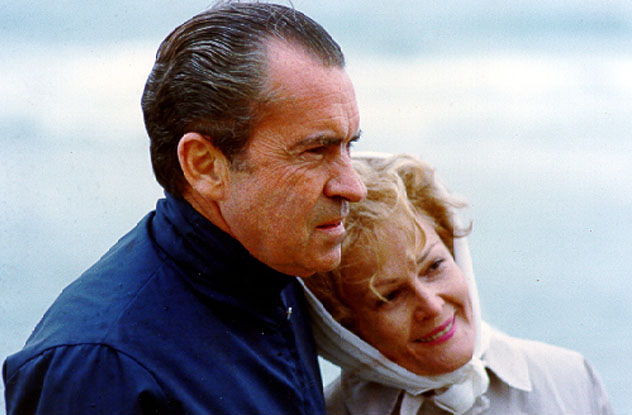
If you described Richard Nixon with one word, you might choose “crook,” “cunning,” or “complicated.” You probably wouldn’t pick “Casanova.” But despite his gruff demeanor, Nixon was really a romantic at heart. He was totally smitten with his wife Pat. The two met at a community theater in 1938, and for Nixon, it was love at first sight. Only Pat wasn’t all that interested in Nixon, leading the young man to some pretty desperate behavior.
While learning how to ice skate so he could hang out with Pat might be cute, driving her to dates with other men bordered between “true love” and “unhealthy obsession.” However, his persistence paid off, and soon Richard and Pat were an item.
When the two weren’t together, they wrote letters to each other, some of which sounded like they were ripped out of a romance novel. “Every day and every night I want to see you and be with you,” Nixon wrote. “Yet I have no feeling of selfish ownership or jealousy. Let’s go for a long ride Sunday; let’s go to the mountains weekends; let’s read books in front of fires; most of all, let’s really grow together and find the happiness we know is ours.”
In addition to his twitterpated soliloquies, Nixon referred to Pat as his “Irish gypsy” and “dearest heart.” Pat also had her own nickname for Nixon, “Plum,” but her letters were usually a bit more grounded than his. Responding to one of his passionate notes, Pat wrote, “In case I don’t see you before, why don’t you come early Wednesday—and I’ll see if I can burn a hamburger for you.” She didn’t need to be sappy. Nixon gushed enough for both of them.
In one letter, he mentioned the “grand poetic music” that filled his heart when he saw her, and he always referred to her as “thee,” a Quaker pronoun used to denote closeness. (Nixon was raised a Quaker.) The courtship culminated with a proposal on cliffs overlooking the ocean and an engagement ring nestled in a basket of flowers.
While it’s hard to believe Nixon could write corny love letters, it goes to show everyone is much more complex than history books lead us to believe.
4He Argued Before The Supreme Court

Richard Nixon was no stranger to the Supreme Court. During his presidency, he nominated four justices, three of whom ruled against him in United States v. Nixon. But before he took his Oath of Office, Nixon found himself in a unique club. In 1966, he argued a case before the Supreme Court, making him one of only eight presidents to do so. Appropriately enough, Nixon was fighting against freedom of the press.
The story starts in 1952, when three escaped convicts invaded a home in Lewisburg, Pennsylvania, taking the Hill family hostage. While it was a tense situation, the criminals had no intention of hurting the family, and after 19 hours, they made a break for it, leaving the Hills behind. All three crooks were killed or captured, and the story sparked a media frenzy. But despite their chance at fame, the Hills withdrew from the public eye, wanting to avoid the spotlight.
The story inspired a play called The Desperate Hours, starring a young Paul Newman as a character much more violent than his real-life counterpart. As part of their coverage of the play, Life magazine wrote about the Hill family, drawing attention to their case and holding a photo shoot inside the Hills’ old home. (The family had moved out since the incident.) The photos included actors staging fictional scenes of violence, and while the sensationalistic coverage might have sold copies, it made the Hills quite unhappy. They felt their privacy had been violated and sued Time, Inc. for damages.
The case reached the Supreme Court, where Richard Nixon, four years after his gubernatorial loss, defended the Hills. Nixon poured his heart and soul into the case, studying numerous texts and taking stacks of notes. Despite his best efforts, Nixon lost the case 5–4.
While it might seem like an insignificant footnote in Nixon’s life, Time Inc. v. Hill shows that, given different choices and circumstances, Nixon might’ve become a legal warrior instead of the crook we know today.
3Nixon The Cinephile

With his ultra-conservative leanings and communist witch-hunting history, you probably wouldn’t expect Richard Nixon to be a movie buff. In his autobiography, the ex-president even wrote, “Hollywood is sick . . . Its values are not those of mainstream America.” But as it turns out, Nixon was actually quite the cinephile. When the man wasn’t leading the country or faking moon landings on Venus, he was privately screening his favorite films almost every Friday and Saturday night. In fact, during his presidency, he watched 528 films.
Not surprisingly, Nixon’s favorite actors were conservative. He was a big fan of Jimmy Stewart, John Wayne, and Clint Eastwood, and while he enjoyed watching an Audrey Hepburn film now and again, he didn’t usually enjoy movies with women protagonists. Yet The Sound of Music was an exception. For some reason, Nixon was really into musicals, except West Side Story, which he considered propaganda. His two favorite films were Around the World in 80 Days and, a little more disturbingly, Patton. In fact, Nixon watched the war classic three times in the days leading up to his invasion of Cambodia.
But perhaps the weirdest moment in Nixon’s cinematic life came when he shook hands with RoboCop at a board meeting for the National Boys Club of America. Their meeting was part of a campaign to promote the release of RoboCop on VHS (which cost a staggering $89.99). No one knows if Nixon ever actually watched Paul Verhoeven’s authoritarian satire, but that’s just as well. He probably would’ve hated it.
2Debating Hippies
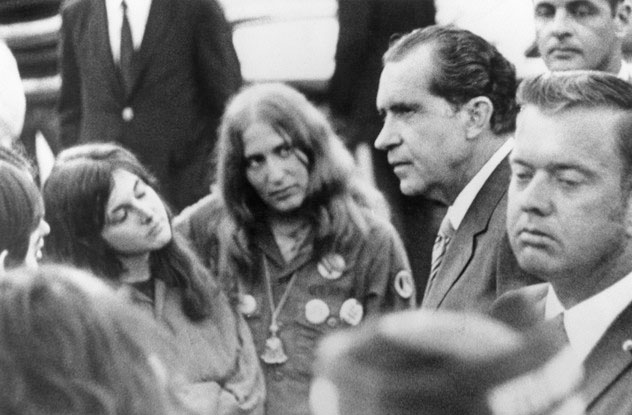
Richard Nixon had a lousy track record when it came to debating. He famously lost his on-air showdown with John F. Kennedy and didn’t fare any better during his contentious interview with David Frost. However, Nixon’s weirdest debate came on May 9, 1970 when he faced a group of college students at the Lincoln Memorial.
It was four in the morning, and Nixon was listening to classical music in the Lincoln Sitting Room when he learned a group of students were gathering at the nearby Lincoln Memorial. Suddenly, Nixon got a terrible idea. Why not head out on the National Mall and debate the angry protestors? At this point, he’d just okayed the invasion of a foreign country that sparked fury across the nation and led to four deaths at Kent State University—but he thought a debate might be a fine idea.
After rounding up his valet, doctor, and a group of extremely edgy Secret Service agents, Nixon drove out to the Memorial, walked up the steps, and started greeting the crowd. What happened next? Well, it depends on whom you ask.
If you asked the president (a neat trick, considering he’s dead), he’d tell you he was on top of his game. If you were to ask the students, they’d tell you Nixon was rambling incoherently and wouldn’t make eye contact with anyone. And if you asked Nixon’s Chief of Staff, H.R. Haldeman, he’d tell you it was “the weirdest day” of Nixon’s presidency—“so far.”
Nixon started by asking the students where they were from and how old they were. He next steered the conversation into college football, a topic the kids found preposterous considering the state of the nation. Nixon then encouraged the students to travel the world, before touching on pollution and ever-so-briefly mentioning Vietnam.
Reportedly, the group had a hard time following Nixon’s train of thought as he taught them that “ending the war and cleaning up the city streets and the air and the water was not going to solve the spiritual hunger which all of us have, which of course has been the great mystery of life from the beginning of time.”
As the group of students started to swell, the Secret Service agents kept trying to get Nixon to leave, but he brushed them off every time. Not until sunrise did the president decide to head back to the White House. After posing for a brief photo op with one of the students, Nixon left the Lincoln Memorial, content he’d straightened up a few lost kids. In reality, he’d left them more confused than ever.
1His Administration Tried To Kill A Journalist

President Nixon wasn’t incredibly fond of reporters, especially the ones who stuck their noses into his business. Numerous journalists ended up on Nixon’s enemies list. Quite a few were harassed by the plumbers, Nixon’s political hit men who dug up dirt on opponents, often through illegal means. While the plumbers usually relied on the tried and true tactic of smearing a reporter’s reputation, they occasionally got really nasty, like the time they almost murdered Jack Anderson.
Anderson was lovingly known around the White House as a “great thorn in the side of the president.”Nixon had been in Anderson’s sights ever since the ’50s, and things only ramped up when Tricky Dick won the 1968 presidential election. For example, Anderson published a story revealing Nixon was secretly supplying Pakistan with weapons in its 1971 war against India. He quickly followed that piece with an article exposing the Nixon administration’s taking bribes in exchange for dropping an investigation of the ITT Corporation. According to White House recordings, Nixon was furious and spent hours discussing Anderson with his aides. In one of his calmer moments, Nixon said, “I would like to get him . . . discredited.”
Nixon’s people did everything they could to destroy Jack Anderson’s reputation. H.R. Haldeman investigated the reporter, his friends, his family members, and his business associates. The administration threatened to charge him with criminal offenses. They thought about supplying him with false information to sully his reputation as a journalist and debated whether to claim he was gay.
Despite their best efforts, they couldn’t destroy Anderson’s standing, so they decided it was time to take him out of the picture entirely. According to White House plumbers E. Howard Hunt and G. Gordon Liddy, White House special counsel Charles Colson gave them direct orders to assassinate Anderson. And according to Hunt, there’s no way Colson would’ve given them such a plan without Nixon’s direct approval.
Liddy and Hunt followed Anderson wherever he went and examined his house, looking for ways to sneak inside. After meeting up with a CIA doctor skilled in the “unorthodox application of medical and chemical knowledge,” (translation: assassination), the two decided to go with one of two options. Either they would break into Anderson’s house and plant a poisonous pill in one of his medicine bottle or they would coat the steering wheel of his car with a massive amount of LSD.
Fortunately for Anderson, the plan was called off. It turned out that Liddy and Hunt had an even more important job to do. Their next assignment was to take a few microphones and bug the Watergate hotel. And the rest, as they say, is history.
Nolan Moore loves singing “The Ballad of Richard Nixon.” If you want, you can write Nolan an email or friend/follow him on Facebook.





